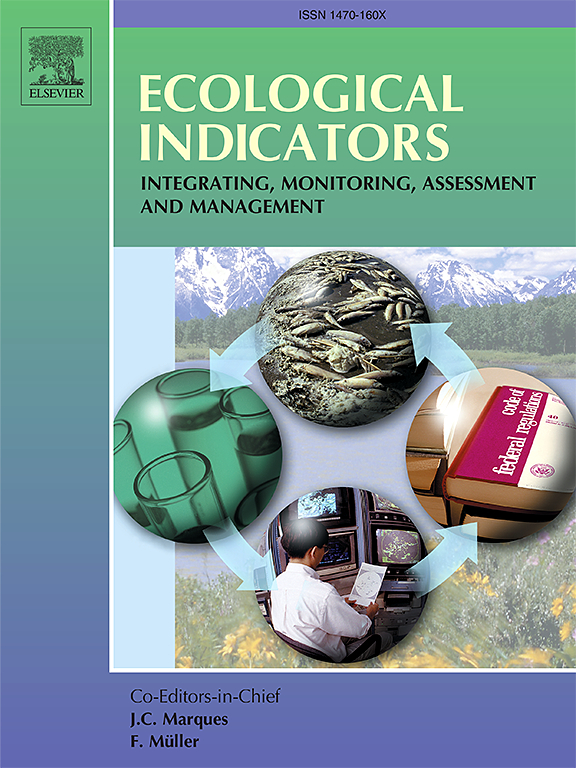Unravelling the spatiotemporal trade-offs and synergies among hydrological ecosystem services in a large floodplain lake
IF 7
2区 环境科学与生态学
Q1 ENVIRONMENTAL SCIENCES
引用次数: 0
Abstract
Understanding the dynamics of ecosystem services (ESs) and their interactions is vital for effective environmental management. This knowledge remains limited in highly dynamic systems, however, particularly floodplain lakes. In this study, spatiotemporal relationships were examined among four leading hydrological ESs (i.e., water supply, flood regulation, nutrient retention, and habitat support) in a large floodplain lake (i.e., Poyang Lake, China). Ecologically relevant hydrological variables were derived through two-dimensional hydrodynamic modeling and served as key ESs indicators. Specifically, water supply was represented by lake storage, flood regulation by changes in lake storage, nutrient retention service by TP retention rate calculated through an empirical model, and the habitat support by the area and presence of suitable water depth of two key biodiversity components. Results showed that hydrological processes and topographical gradients regulated the ES dynamics and interactions in Poyang Lake across time and space. The water supply service exhibited a significant co-occurrence relationship with the flood regulation and nutrient retention services, whereas a trade-off occurred with the habitat support service. However, dynamic shifts of trade-offs and synergies occurred among all ES pairs throughout the hydrological year. Spatially, the main lake channel was a hotspot for water supply, flood regulation, and habitat support services, each of which displayed significant synergistic relationships. Trade-offs occurred between water supply and nutrient retention at the southwestern edge of the wetland, as well as between habitat support and the other ESs in the central lake. Moreover, mismatches in the spatial and temporal trade- offs and synergies were identified between water supply and both nutrient retention and the habitat support services, underscoring the need for careful management strategies that can balance the spatiotemporal trade-offs and synergies of multiple ESs. This study offers valuable insights into the dynamic relationships among ESs in floodplain lakes and could provide guidance for coordinated promotion of multiple ESs in Poyang Lake and similar floodplain systems.

大型洪泛平原湖泊水文生态系统服务的时空权衡与协同效应
了解生态系统服务的动态及其相互作用对有效的环境管理至关重要。然而,这种知识在高度动态系统中仍然有限,特别是在洪泛平原湖泊中。本研究以鄱阳湖为研究对象,研究了鄱阳湖四种主要水文ESs(即供水、洪水调节、养分保持和生境支持)的时空关系。生态相关水文变量通过二维水动力学建模得到,并作为关键的ESs指标。其中,湖泊蓄水量代表水供应,湖泊蓄水量变化代表洪水调节,经验模型计算的TP保留率代表养分保留服务,两个关键生物多样性组成部分的面积和适宜水深代表生境支持。结果表明,水文过程和地形梯度调节着鄱阳湖ES的时空动态和相互作用。供水服务与洪水调节和营养保持服务表现出显著的共生关系,而与栖息地支持服务则表现出权衡关系。然而,在整个水文年期间,所有ES对之间都发生了权衡和协同效应的动态变化。在空间上,主湖通道是供水、防洪和生境支持服务的热点,三者之间表现出显著的协同关系。在湿地西南边缘的供水和养分保留之间,以及在中央湖泊的生境支持和其他ESs之间,存在权衡。此外,还发现了供水与营养保持和生境支持服务之间的时空权衡和协同效应的不匹配,强调需要谨慎的管理策略,以平衡多个生态系统的时空权衡和协同效应。该研究为进一步了解河漫滩湖泊生态系统间的动态关系提供了有价值的见解,可为鄱阳湖及类似河漫滩系统中多个生态系统的协同推进提供指导。
本文章由计算机程序翻译,如有差异,请以英文原文为准。
求助全文
约1分钟内获得全文
求助全文
来源期刊

Ecological Indicators
环境科学-环境科学
CiteScore
11.80
自引率
8.70%
发文量
1163
审稿时长
78 days
期刊介绍:
The ultimate aim of Ecological Indicators is to integrate the monitoring and assessment of ecological and environmental indicators with management practices. The journal provides a forum for the discussion of the applied scientific development and review of traditional indicator approaches as well as for theoretical, modelling and quantitative applications such as index development. Research into the following areas will be published.
• All aspects of ecological and environmental indicators and indices.
• New indicators, and new approaches and methods for indicator development, testing and use.
• Development and modelling of indices, e.g. application of indicator suites across multiple scales and resources.
• Analysis and research of resource, system- and scale-specific indicators.
• Methods for integration of social and other valuation metrics for the production of scientifically rigorous and politically-relevant assessments using indicator-based monitoring and assessment programs.
• How research indicators can be transformed into direct application for management purposes.
• Broader assessment objectives and methods, e.g. biodiversity, biological integrity, and sustainability, through the use of indicators.
• Resource-specific indicators such as landscape, agroecosystems, forests, wetlands, etc.
 求助内容:
求助内容: 应助结果提醒方式:
应助结果提醒方式:


